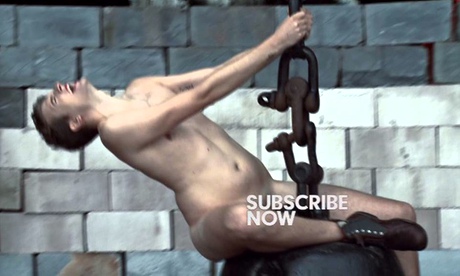
A video of Radio 1 DJ Greg James naked on a wrecking ball might seem an unlikely glimpse into the future of the BBC’s youth radio station. But with Radio 1 increasingly looking to online video and social media to engage young audiences who are shunning traditional radio, James’s YouTube success in parodying the Miley Cyrus Wrecking Ball promo has taken on a new importance.
This change is taking place under the leadership of Ben Cooper, who has pursued a strategy of “listen, watch, share” since he became controller of Radio 1 and 1Xtra in 2011, in an attempt to engage with what he calls the “head down” generation of mobile- and laptop-fixated teens for whom YouTube is the most important platform for music.
The latest step towards this goal was the announcement last week of a dedicated space on the iPlayer for Radio 1’s visual content, building on the success of the Radio 1 YouTube channel, which has the most subscribers – 1.4 million – of any radio station on the platform. The proposed iPlayer channel, subject to the approval of the BBC Trust with a decision expected in early October, will feature videos of live performances, highlights from Radio 1 events, interviews and “more random, creative moments”, such as James’s parody video.
The move – tipping Radio 1 towards becoming a video channel as well as a music radio station – may take the network further away from its broadcast origins. But it ties into a desire to reach out to younger audiences using technology – see also last year’s launch of the Playlister music recommendation service – as well as changing music consumption patterns and broader BBC strategic thinking.
Director general Tony Hall explained last October that Radio 1 “is no longer just a radio station – it’s already filming sessions, interviews and programmes that live online. Its audience can now listen, watch and share its music performances.”
Cooper unsurprisingly shares his boss’s platform-agnostic view. “It is wrong to keep thinking about radio and TV stations,” he says. “You need to start thinking about brands.
“The ultimate goal [of initiatives like the iPlayer channel] is quite ambitious. I would like to see the BBC become the UK’s favourite youth brand.”
To help fulfil this lofty ambition, Cooper says Radio 1 has to crack two key problems: distribution of content and measuring success in the modern digital world. “We used to distribute our great content through the radio. Now young people have maybe a radio in the kitchen, a mobile phone, a laptop and a tablet,” he explains. “What are the right times to distribute this content – the right times, the right platform and the right device? That is the key to still being relevant.”
The issue of how to measure success could prove extremely complicated, however. The UK radio industry continues to look to the quarterly Rajar listening figures as a yardstick of achievement, but Cooper says these stats, while “a very important part of what we do”, don’t accurately reflect the full extent of audience engagement. “If you listen to Radio 1 in the background all day, is that really a very good figure for us to judge how successful Radio 1 is?” he asks. “Or is going to YouTube to look at four different videos and posting them on social media more valuable?”
Radio 1 performed well in the most recent quarterly Rajar figures, released last week, with an average weekly audience of 10.8 million listeners, up 270,000 on the previous quarter. But Cooper points out that the station’s audience is tuning in for less time. “What are they doing? They are on a screen, YouTube and social media,” he says. “If you want young people to bump into Radio 1, we increase our chances by being on YouTube and social media.”
Another key development among the youthful Radio 1 demographic is that audiences are no longer passive consumers, becoming active participants in the media conversation by sharing content – the “share” in Cooper’s mantra of “listen, watch, share”. Whether his network can produce compelling, share-worthy content of the kind that will attract a young audience is another matter, although the success of James’s Wrecking Ball video (5.7m views and 5,700 shares on YouTube) or Miley Cyrus’s Radio 1 Live Lounge cover of Lana Del Rey’s Summertime Sadness (14.5m views and 29,700 shares) is promising.
Paul Robinson, former BBC Radio head of strategy, remains unconvinced that young people will visit a BBC – “ie, establishment” – destination for online video, even with a dedicated space on the iPlayer. “Perhaps the bigger problem is that Ben hasn’t given any reason to go to it,” Robinson says. “There isn’t a compelling content offer to consumers. The chance to see Big Weekend or Live Lounge performances or DJs doing wacky stunts is fine, but is it enough to change young people’s behaviour? I don’t think so.”
The wider question is whether Radio 1, now in its fifth decade of existence, can stay relevant to a young audience brought up on the all-you-can-eat infinite musical jukeboxes of YouTube and Spotify and the interactivity of social media.
This will be quite a task. But Cooper is naturally confident. “What we need to do is to represent the zeitgeist of what it feels like to be young, to reflect and celebrate youth culture in the UK,” he says. “If we can do that with the right presenters and content then we can continue to be relevant.”

